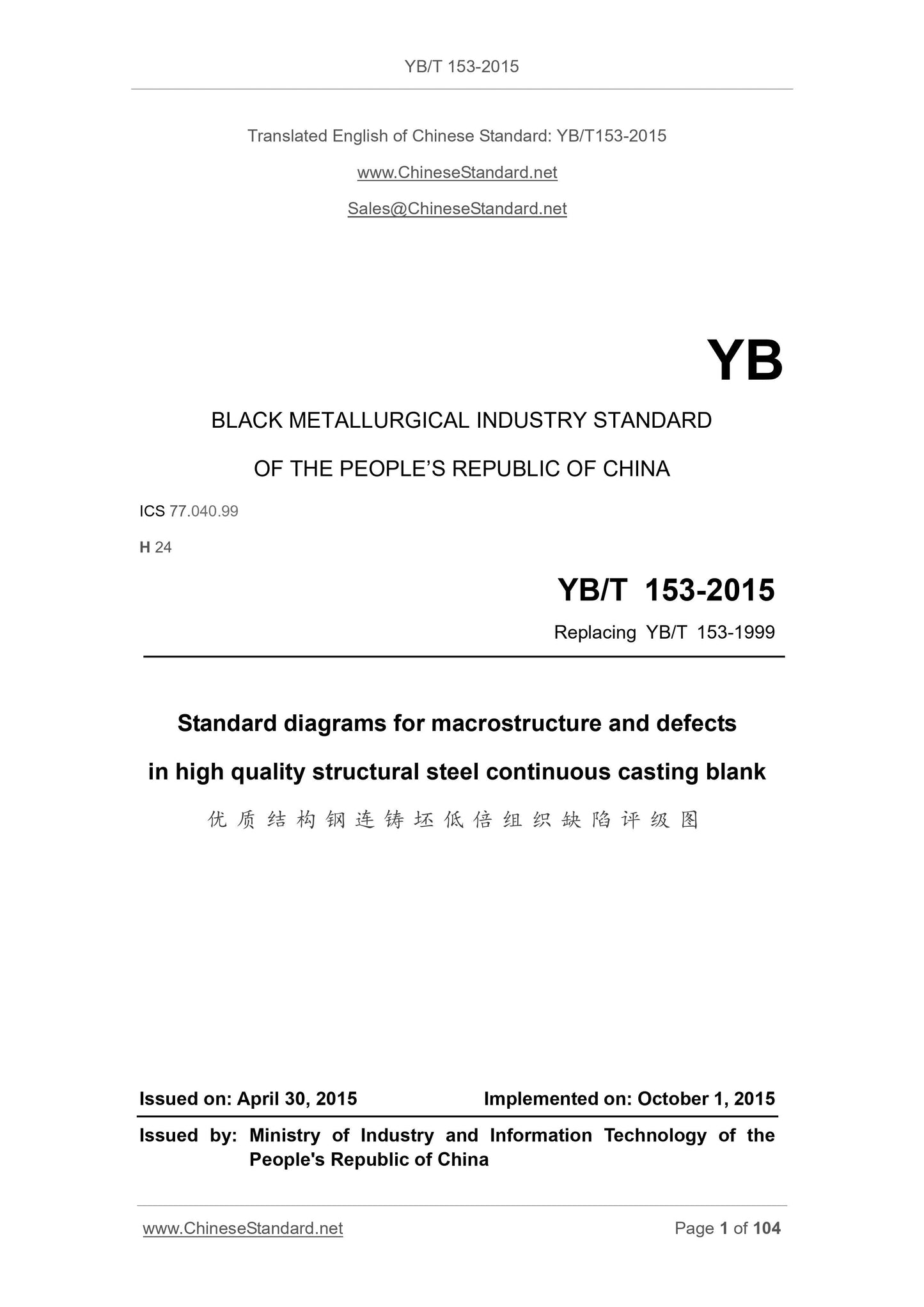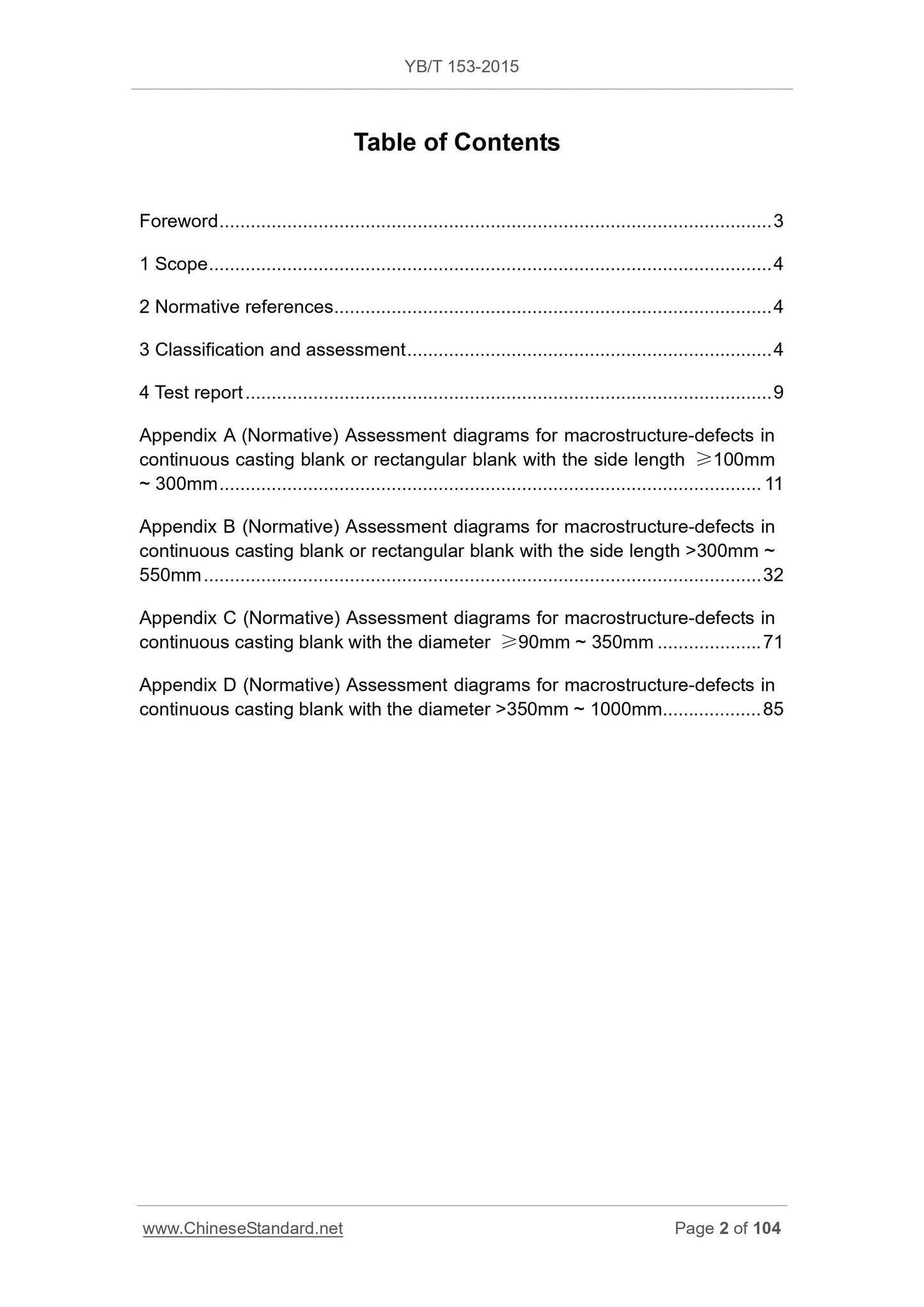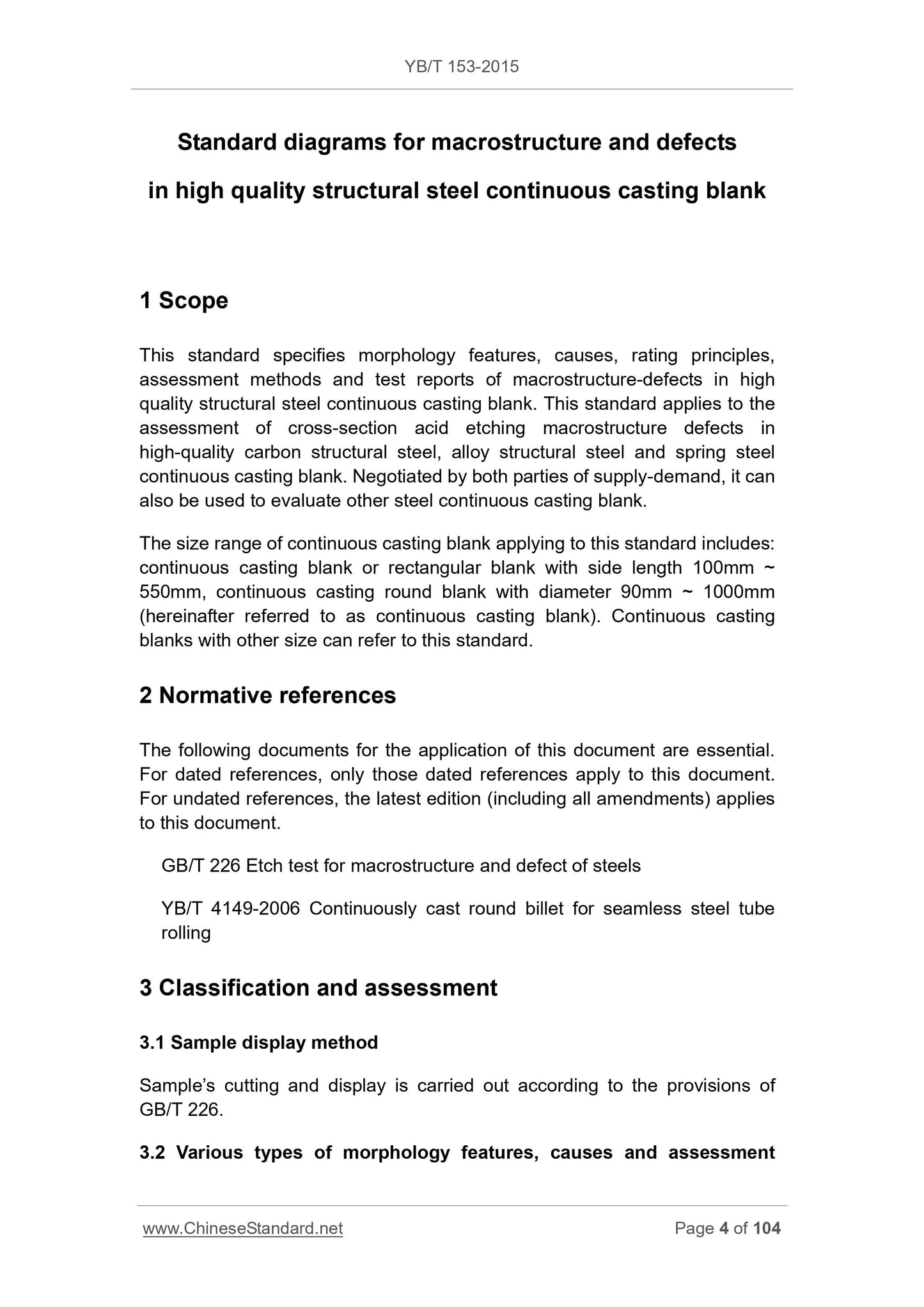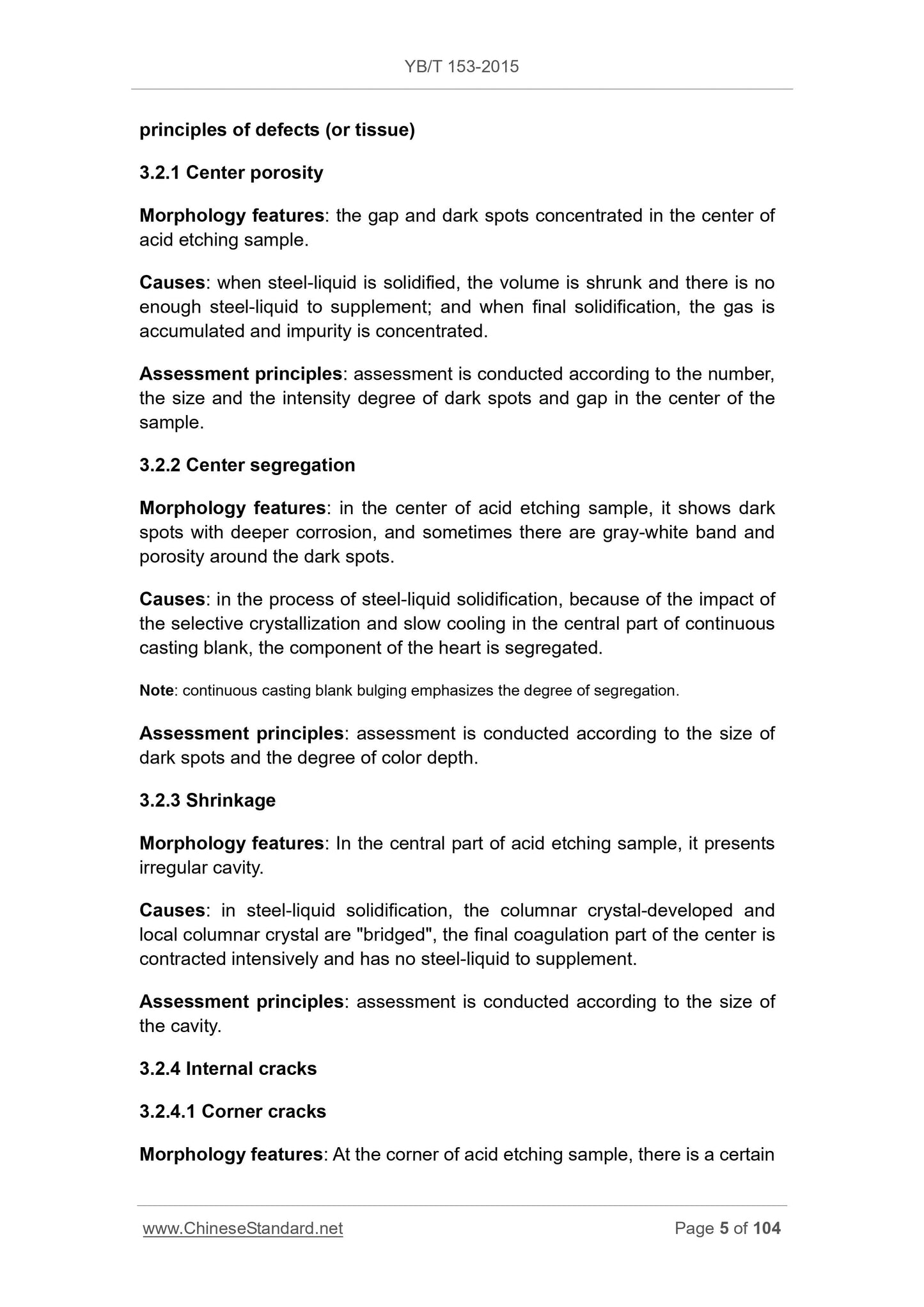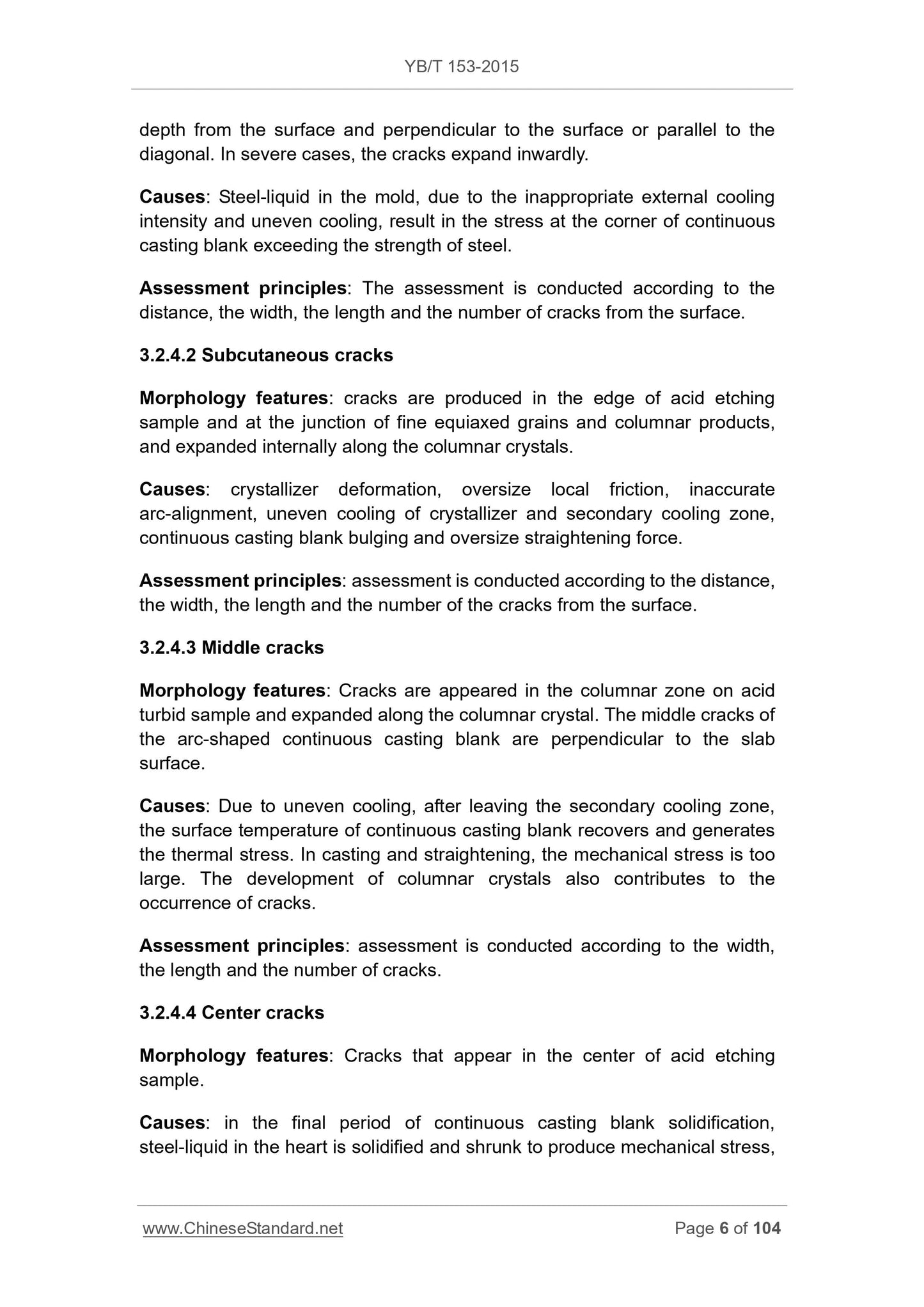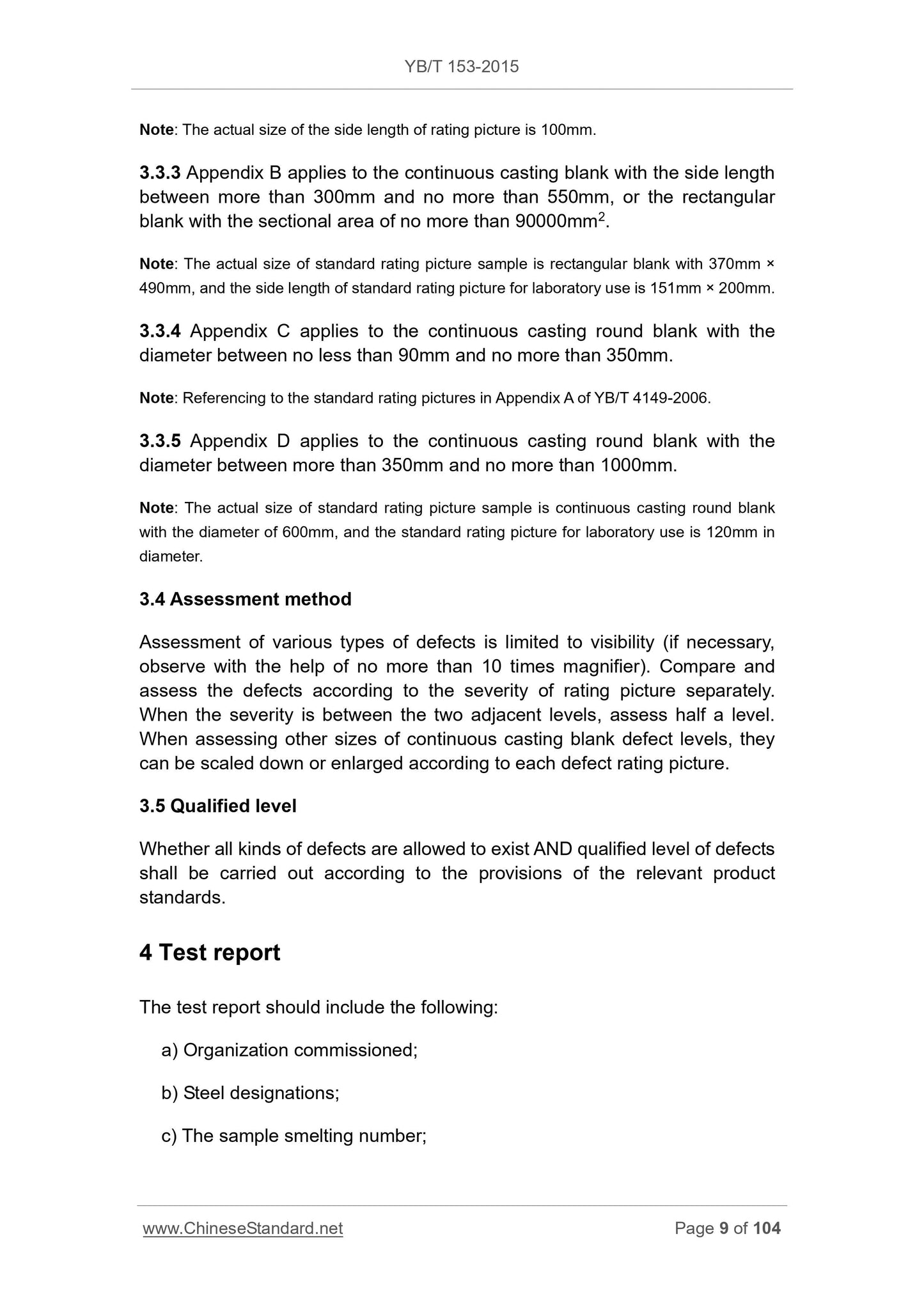1
/
of
7
PayPal, credit cards. Download editable-PDF and invoice in 1 second!
YB/T 153-2015 English PDF (YBT153-2015)
YB/T 153-2015 English PDF (YBT153-2015)
Regular price
$555.00 USD
Regular price
Sale price
$555.00 USD
Unit price
/
per
Shipping calculated at checkout.
Couldn't load pickup availability
Delivery: 3 seconds. Download true-PDF + Invoice.
Get QUOTATION in 1-minute: Click YB/T 153-2015
Historical versions: YB/T 153-2015
Preview True-PDF (Reload/Scroll if blank)
YB/T 153-2015: Standard diagrams for macrostructure and defects in high quality structural steel continuous casting blank
YB/T 153-2015
YB
BLACK METALLURGICAL INDUSTRY STANDARD
OF THE PEOPLE’S REPUBLIC OF CHINA
ICS 77.040.99
H 24
Replacing YB/T 153-1999
Standard diagrams for macrostructure and defects
in high quality structural steel continuous casting blank
ISSUED ON: APRIL 30, 2015
IMPLEMENTED ON: OCTOBER 1, 2015
Issued by: Ministry of Industry and Information Technology of the
People's Republic of China
Table of Contents
Foreword ... 3
1 Scope ... 4
2 Normative references ... 4
3 Classification and assessment ... 4
4 Test report ... 9
Appendix A (Normative) Assessment diagrams for macrostructure-defects in
continuous casting blank or rectangular blank with the side length ≥100mm
~ 300mm ... 11
Appendix B (Normative) Assessment diagrams for macrostructure-defects in
continuous casting blank or rectangular blank with the side length >300mm ~
550mm ... 32
Appendix C (Normative) Assessment diagrams for macrostructure-defects in
continuous casting blank with the diameter ≥90mm ~ 350mm ... 71
Appendix D (Normative) Assessment diagrams for macrostructure-defects in
continuous casting blank with the diameter >350mm ~ 1000mm... 85
Standard diagrams for macrostructure and defects
in high quality structural steel continuous casting blank
1 Scope
This standard specifies morphology features, causes, rating principles,
assessment methods and test reports of macrostructure-defects in high
quality structural steel continuous casting blank. This standard applies to the
assessment of cross-section acid etching macrostructure defects in
high-quality carbon structural steel, alloy structural steel and spring steel
continuous casting blank. Negotiated by both parties of supply-demand, it can
also be used to evaluate other steel continuous casting blank.
The size range of continuous casting blank applying to this standard includes:
continuous casting blank or rectangular blank with side length 100mm ~
550mm, continuous casting round blank with diameter 90mm ~ 1000mm
(hereinafter referred to as continuous casting blank). Continuous casting
blanks with other size can refer to this standard.
2 Normative references
The following documents for the application of this document are essential.
For dated references, only those dated references apply to this document.
For undated references, the latest edition (including all amendments) applies
to this document.
GB/T 226 Etch test for macrostructure and defect of steels
YB/T 4149-2006 Continuously cast round billet for seamless steel tube
rolling
3 Classification and assessment
3.1 Sample display method
Sample’s cutting and display is carried out according to the provisions of
GB/T 226.
3.2 Various types of morphology features, causes and assessment
principles of defects (or tissue)
3.2.1 Center porosity
Morphology features: the gap and dark spots concentrated in the center of
acid etching sample.
Causes: when steel-liquid is solidified, the volume is shrunk and there is no
enough steel-liquid to supplement; and when final solidification, the gas is
accumulated and impurity is concentrated.
Assessment principles: assessment is conducted according to the number,
the size and the intensity degree of dark spots and gap in the center of the
sample.
3.2.2 Center segregation
Morphology features: in the center of acid etching sample, it shows dark
spots with deeper corrosion, and sometimes there are gray-white band and
porosity around the dark spots.
Causes: in the process of steel-liquid solidification, because of the impact of
the selective crystallization and slow cooling in the central part of continuous
casting blank, the component of the heart is segregated.
Note: continuous casting blank bulging emphasizes the degree of segregation.
Assessment principles: assessment is conducted according to the size of
dark spots and the degree of color depth.
3.2.3 Shrinkage
Morphology features: In the central part of acid etching sample, it presents
irregular cavity.
Causes: in steel-liquid solidification, the columnar crystal-developed and
local columnar crystal are "bridged", the final coagulation part of the center is
contracted intensively and has no steel-liquid to supplement.
Assessment principles: assessment is conducted according to the size of
the cavity.
3.2.4 Internal cracks
3.2.4.1 Corner cracks
Morphology features: At the corner of acid etching sample, there is a certain
depth from the surface and perpendicular to the surface or parallel to the
diagonal. In severe cases, the cracks expand inwardly.
Causes: Steel-liquid in the mold, due to the inappropriate external cooling
intensity and uneven cooling, result in the stress at the corner of continuous
casting blank exceeding the strength of steel.
Assessment principles: The assessment is conducted according to the
distance, the width, the length and the number of cracks from the surface.
3.2.4.2 Subcutaneous cracks
Morphology features: cracks are produced in the edge of acid etching
sample and at the junction of fine equiaxed grains and columnar products,
and expanded internally along the columnar crystals.
Causes: crystallizer deformation, oversize local friction, inaccurate
arc-alignment, uneven cooling of crystallizer and secondary cooling zone,
continuous casting blank bulging and oversize straightening force.
Assessment principles: assessment is conducted according to the distance,
the width, the length and the number of the cracks from the surface.
3.2.4.3 Middle cracks
Morphology features: Cracks are appeared in the columnar zone on acid
turbid sample and expanded along the columnar crystal. The middle cracks of
the arc-shaped continuous casting blank are perpendicular to the slab
surface.
Causes: Due to uneven cooling, after leaving the secondary cooling zone,
the surface temperature of continuous casting blank recovers and generates
the thermal stress. In casting and straightening, the mechanical stress is too
large. The development of columnar crystals also contributes to the
occurrence of cracks.
Assessment principles: assessment is conducted according to the width,
the length and the number of cracks.
3.2.4.4 Center cracks
Morphology features: Cracks that appear in the center of acid etching
sample.
Causes: in the final period of continuous casting blank solidification,
steel-liquid in the heart is solidified and shrunk to produce mechanical stress,
Morphology features: Clumps or particles of different colors and shapes are
presented on the acid etching sample.
Causes: Tundish low liquid level pouring generates vortex to inhale slag into
crystallizer, which is failed to float up and separate. Or because the liquid
level fluctuation in the crystallizer is too large, the slag involving in the
steel-liquid before coagulation cannot float up to form center slag. The slag
near the surface of continuous casting blank is subcutaneous slag.
Record the size, the digit and the position of slag inclusion during the
assessment.
3.2.4.9 Foreign impurity metal
Morphology features: The metal block of no certain shape presents different
color and matrix on acid etching sample. Some have obvious boundaries with
matrix, and some have no obvious boundaries.
Causes: because the added alloy materials or the plunged dissimilar metals
are not completely melted before pouring.
During the assessment, record the size and the location of...
Get QUOTATION in 1-minute: Click YB/T 153-2015
Historical versions: YB/T 153-2015
Preview True-PDF (Reload/Scroll if blank)
YB/T 153-2015: Standard diagrams for macrostructure and defects in high quality structural steel continuous casting blank
YB/T 153-2015
YB
BLACK METALLURGICAL INDUSTRY STANDARD
OF THE PEOPLE’S REPUBLIC OF CHINA
ICS 77.040.99
H 24
Replacing YB/T 153-1999
Standard diagrams for macrostructure and defects
in high quality structural steel continuous casting blank
ISSUED ON: APRIL 30, 2015
IMPLEMENTED ON: OCTOBER 1, 2015
Issued by: Ministry of Industry and Information Technology of the
People's Republic of China
Table of Contents
Foreword ... 3
1 Scope ... 4
2 Normative references ... 4
3 Classification and assessment ... 4
4 Test report ... 9
Appendix A (Normative) Assessment diagrams for macrostructure-defects in
continuous casting blank or rectangular blank with the side length ≥100mm
~ 300mm ... 11
Appendix B (Normative) Assessment diagrams for macrostructure-defects in
continuous casting blank or rectangular blank with the side length >300mm ~
550mm ... 32
Appendix C (Normative) Assessment diagrams for macrostructure-defects in
continuous casting blank with the diameter ≥90mm ~ 350mm ... 71
Appendix D (Normative) Assessment diagrams for macrostructure-defects in
continuous casting blank with the diameter >350mm ~ 1000mm... 85
Standard diagrams for macrostructure and defects
in high quality structural steel continuous casting blank
1 Scope
This standard specifies morphology features, causes, rating principles,
assessment methods and test reports of macrostructure-defects in high
quality structural steel continuous casting blank. This standard applies to the
assessment of cross-section acid etching macrostructure defects in
high-quality carbon structural steel, alloy structural steel and spring steel
continuous casting blank. Negotiated by both parties of supply-demand, it can
also be used to evaluate other steel continuous casting blank.
The size range of continuous casting blank applying to this standard includes:
continuous casting blank or rectangular blank with side length 100mm ~
550mm, continuous casting round blank with diameter 90mm ~ 1000mm
(hereinafter referred to as continuous casting blank). Continuous casting
blanks with other size can refer to this standard.
2 Normative references
The following documents for the application of this document are essential.
For dated references, only those dated references apply to this document.
For undated references, the latest edition (including all amendments) applies
to this document.
GB/T 226 Etch test for macrostructure and defect of steels
YB/T 4149-2006 Continuously cast round billet for seamless steel tube
rolling
3 Classification and assessment
3.1 Sample display method
Sample’s cutting and display is carried out according to the provisions of
GB/T 226.
3.2 Various types of morphology features, causes and assessment
principles of defects (or tissue)
3.2.1 Center porosity
Morphology features: the gap and dark spots concentrated in the center of
acid etching sample.
Causes: when steel-liquid is solidified, the volume is shrunk and there is no
enough steel-liquid to supplement; and when final solidification, the gas is
accumulated and impurity is concentrated.
Assessment principles: assessment is conducted according to the number,
the size and the intensity degree of dark spots and gap in the center of the
sample.
3.2.2 Center segregation
Morphology features: in the center of acid etching sample, it shows dark
spots with deeper corrosion, and sometimes there are gray-white band and
porosity around the dark spots.
Causes: in the process of steel-liquid solidification, because of the impact of
the selective crystallization and slow cooling in the central part of continuous
casting blank, the component of the heart is segregated.
Note: continuous casting blank bulging emphasizes the degree of segregation.
Assessment principles: assessment is conducted according to the size of
dark spots and the degree of color depth.
3.2.3 Shrinkage
Morphology features: In the central part of acid etching sample, it presents
irregular cavity.
Causes: in steel-liquid solidification, the columnar crystal-developed and
local columnar crystal are "bridged", the final coagulation part of the center is
contracted intensively and has no steel-liquid to supplement.
Assessment principles: assessment is conducted according to the size of
the cavity.
3.2.4 Internal cracks
3.2.4.1 Corner cracks
Morphology features: At the corner of acid etching sample, there is a certain
depth from the surface and perpendicular to the surface or parallel to the
diagonal. In severe cases, the cracks expand inwardly.
Causes: Steel-liquid in the mold, due to the inappropriate external cooling
intensity and uneven cooling, result in the stress at the corner of continuous
casting blank exceeding the strength of steel.
Assessment principles: The assessment is conducted according to the
distance, the width, the length and the number of cracks from the surface.
3.2.4.2 Subcutaneous cracks
Morphology features: cracks are produced in the edge of acid etching
sample and at the junction of fine equiaxed grains and columnar products,
and expanded internally along the columnar crystals.
Causes: crystallizer deformation, oversize local friction, inaccurate
arc-alignment, uneven cooling of crystallizer and secondary cooling zone,
continuous casting blank bulging and oversize straightening force.
Assessment principles: assessment is conducted according to the distance,
the width, the length and the number of the cracks from the surface.
3.2.4.3 Middle cracks
Morphology features: Cracks are appeared in the columnar zone on acid
turbid sample and expanded along the columnar crystal. The middle cracks of
the arc-shaped continuous casting blank are perpendicular to the slab
surface.
Causes: Due to uneven cooling, after leaving the secondary cooling zone,
the surface temperature of continuous casting blank recovers and generates
the thermal stress. In casting and straightening, the mechanical stress is too
large. The development of columnar crystals also contributes to the
occurrence of cracks.
Assessment principles: assessment is conducted according to the width,
the length and the number of cracks.
3.2.4.4 Center cracks
Morphology features: Cracks that appear in the center of acid etching
sample.
Causes: in the final period of continuous casting blank solidification,
steel-liquid in the heart is solidified and shrunk to produce mechanical stress,
Morphology features: Clumps or particles of different colors and shapes are
presented on the acid etching sample.
Causes: Tundish low liquid level pouring generates vortex to inhale slag into
crystallizer, which is failed to float up and separate. Or because the liquid
level fluctuation in the crystallizer is too large, the slag involving in the
steel-liquid before coagulation cannot float up to form center slag. The slag
near the surface of continuous casting blank is subcutaneous slag.
Record the size, the digit and the position of slag inclusion during the
assessment.
3.2.4.9 Foreign impurity metal
Morphology features: The metal block of no certain shape presents different
color and matrix on acid etching sample. Some have obvious boundaries with
matrix, and some have no obvious boundaries.
Causes: because the added alloy materials or the plunged dissimilar metals
are not completely melted before pouring.
During the assessment, record the size and the location of...
Share
